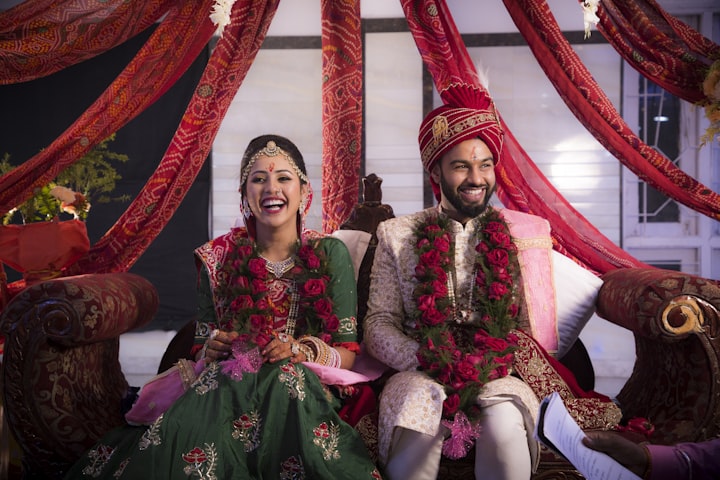Exploring Asian Wedding Traditions: Customs and Rituals
Asian Wedding Traditions

Asian wedding traditions vary greatly depending on the country and culture, but there are some common threads that can be found throughout the continent. For example, family and community are highly valued, and weddings are often large, festive affairs that involve many customs and rituals. From pre-wedding ceremonies to post-wedding celebrations, each stage of an Asian wedding is steeped in tradition and meaning.
Pre-Wedding Traditions
1. Engagement Ceremony
The engagement ceremony is an important pre-wedding ritual that takes place in many Asian cultures. It typically involves a formal announcement of the couple's intention to marry and the exchange of gifts between the families. Depending on the culture, the engagement ceremony may be called by different names, such as Sagai in Indian weddings or Yunio in Korean weddings. The ceremony can be a small affair or a large celebration, depending on the families' preferences.
Significance of the Engagement Ceremony
The engagement ceremony is significant because it marks the formal agreement between the families to proceed with the marriage. It also serves as an opportunity for the families to get to know each other better and to establish a positive relationship. In some cultures, the engagement ceremony is seen as an auspicious time to set the wedding date and to perform other rituals that are believed to bring good luck and blessings to the couple.
2. Mehndi Ceremony
The mehndi ceremony is a festive pre-wedding ritual that is popular in many Asian cultures, particularly in India, Pakistan, and Bangladesh. It involves the application of henna designs to the hands and feet of the bride, as well as to the hands of female family members and friends. The ceremony is often accompanied by music, dancing, and traditional food.
Significance of the Mehndi Ceremony
The mehndi ceremony is significant because it symbolizes the bride's transformation from a young girl to a married woman. The intricate henna designs are believed to bring good luck, fertility, and prosperity to the couple. The ceremony is also a way for the bride and her female relatives and friends to bond and to share in the joy of the upcoming wedding.
3. Sangeet Ceremony
The sangeet ceremony is a lively pre-wedding celebration that is popular in many Indian weddings. It typically involves music, dancing, and performances by family members and friends. The ceremony can be held separately for the bride and groom or as a joint celebration for both families.
Significance of the Sangeet Ceremony
The sangeet ceremony is significant because it provides an opportunity for the families to come together and to celebrate the upcoming wedding in a festive and joyous way. It is also a way for the bride and groom to express their love and affection for each other through song and dance. The sangeet ceremony is often one of the most memorable and enjoyable parts of an Indian wedding, and it is a wonderful way to kick off the wedding festivities.
Wedding Day Traditions
1. Baraat Ce.remony
The baraat ceremony is a traditional groom's wedding procession that is popular in many South Asian cultures, particularly in India and Pakistan. The groom and his family and friends arrive at the wedding venue on horseback, in a decorated car or on foot, accompanied by music and dancing.
Significance of the Baraat Ceremony
The baraat ceremony is significant because it symbolizes the groom's departure from his home and his arrival at the wedding venue. It is also a way for the groom's family and friends to show their love and support for him on his wedding day. The ceremony is often one of the most joyous and energetic parts of an Indian wedding, and it sets the tone for the rest of the day's celebrations.
2. Kanyadaan Ceremony
The kanyadaan ceremony is a traditional Hindu wedding ritual that involves the giving away of the bride by her father or a male relative. The father places his daughter's hand in the groom's hand, symbolizing the transfer of responsibility and protection from the father to the husband.
Hindi weddings are renowned for their beautiful traditions, such as the heartwarming kanyadaan ceremony. Capturing these precious moments through photography can make the occasion even more memorable for the couple and their loved ones. Consider exploring the world of Hindu wedding photography to find the best ways to document this special day.
Significance of the Kanyadaan Ceremony
The kanyadaan ceremony is significant because it symbolizes the father's acceptance of the groom as his daughter's husband and the beginning of a new family. It also signifies the bride's willingness to leave her family and to start a new life with her husband.
3. Varmala Ceremony
The varmala ceremony is a traditional Indian wedding ritual that involves the exchange of garlands between the bride and groom. The bride and groom stand facing each other, and the groom places a flower garland around the bride's neck. The bride then reciprocates by placing a garland around the groom's neck.
Significance of the Varmala Ceremony
The varmala ceremony is significant because it symbolizes the bride and groom's acceptance of each other as partners in marriage. The garlands also represent the couple's commitment to each other and their willingness to love and support each other throughout their lives.
4. Saat Phere Ceremony
The saat phere ceremony is a traditional Hindu wedding ritual that involves the bride and groom taking seven vows while walking around a sacred fire. Each vow corresponds to a specific aspect of married life, such as love, loyalty, and respect.
Significance of the saat phere ceremony
The saat phere ceremony is significant because it symbolizes the couple's commitment to each other and their willingness to share their lives together. The seven vows represent the promises that the couple makes to each other, and the sacred fire represents their spiritual union. The ceremony is often considered the most important part of a Hindu wedding, and it marks the beginning of the couple's journey as husband and wife.
Post-Wedding Traditions
1. Vidai Ceremony
The vidai ceremony is a traditional Hindu wedding ritual that involves the bride bidding farewell to her family and leaving with her husband. The bride throws rice and coins over her head as a symbol of prosperity and thanks her parents for raising her.
Significance of the Vidai Ceremony
The vidai ceremony is significant because it symbolizes the bride's departure from her family and her transition to her new life with her husband. It is often an emotional moment for the bride and her family, as they say goodbye to each other and wish each other well.
2. Reception
The wedding reception is a post-wedding celebration that is often held on the same day as the wedding or the day after. It is a chance for the couple to celebrate their union with their friends and family and to thank them for their support.
Significance of the Reception
The reception is significant because it provides an opportunity for the couple to share their joy and happiness with their loved ones. It is often a lively and festive event, with music, dancing, and food. The reception also allows the couple to show their gratitude to their guests for being a part of their special day.
Tips for Wedding Photography and Videography
Plan ahead: Make sure to discuss your photography and videography needs with your wedding planner or photographer well in advance of your wedding day.
Communicate your vision: Be clear about the style and aesthetic you want for your wedding photos and videos. This will help your photographer and videographer capture the moments that are most important to you.
Hire a professional: Look for a photographer and videographer with experience in Asian weddings. They will be familiar with the customs and traditions and will know how to capture the important moments.
Get to know your photographer and videographer: Schedule a meeting or engagement shoot with your photographer and videographer before the wedding. This will help you get comfortable with them and will give them a better understanding of your personalities and preferences.
Trust your photographer and videographer: On the day of your wedding, focus on enjoying yourself and let your photographer and videographer handle the details. They will capture the moments that matter most and will create beautiful memories that you will cherish for a lifetime.
About the Creator
Silvia James
Silvia James was born in Denver, Colorado, and works as a contract author. She graduated from the College of Colorado, Denver with a bachelor's degree in English. Writing is her best form of networking and expressing herself.






Comments
There are no comments for this story
Be the first to respond and start the conversation.